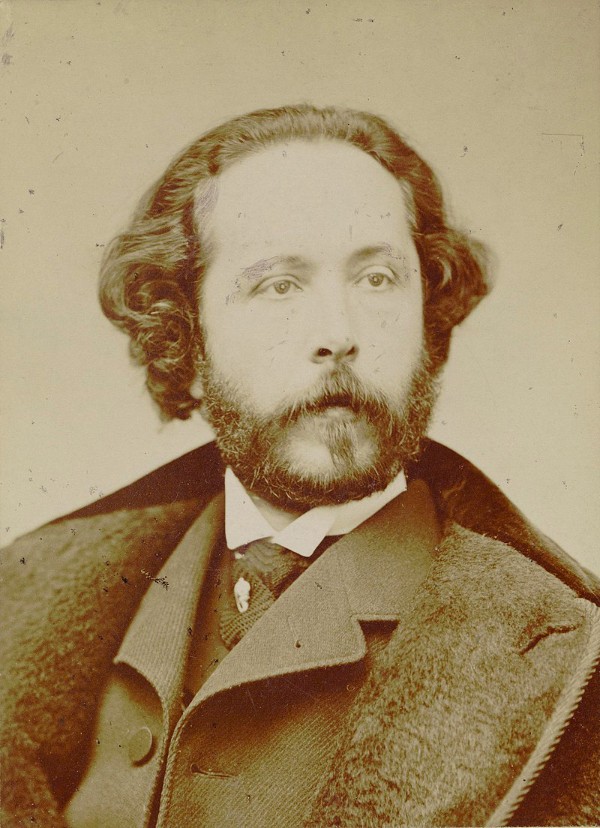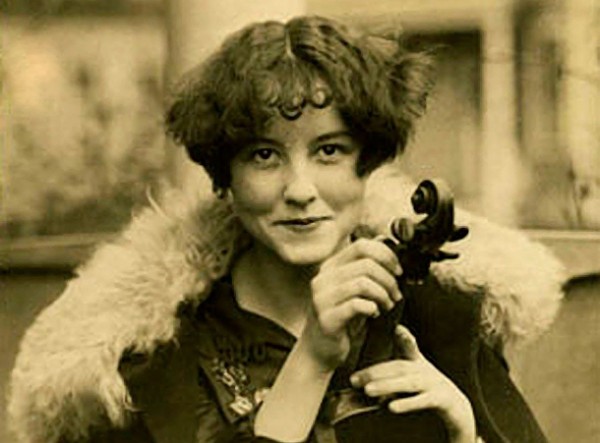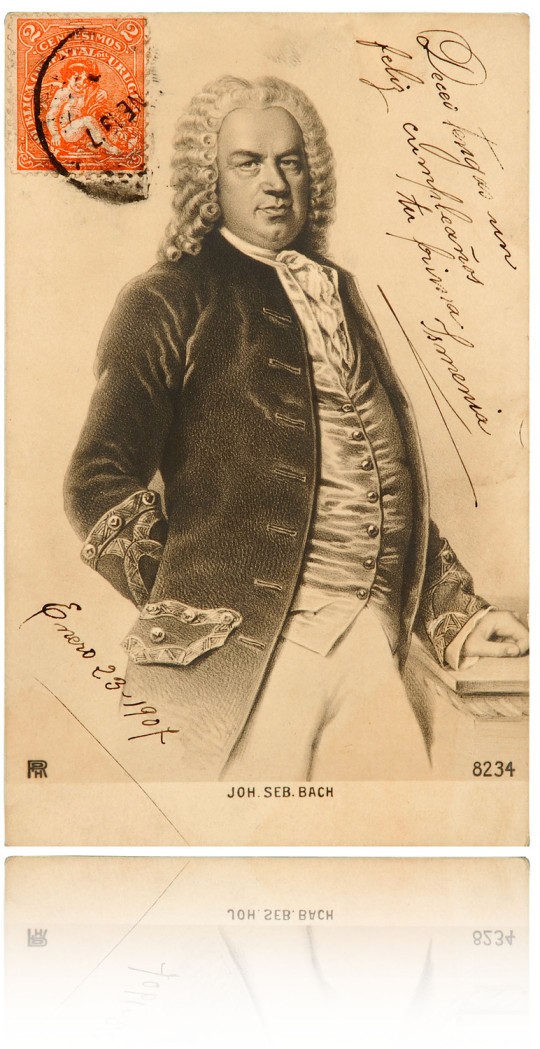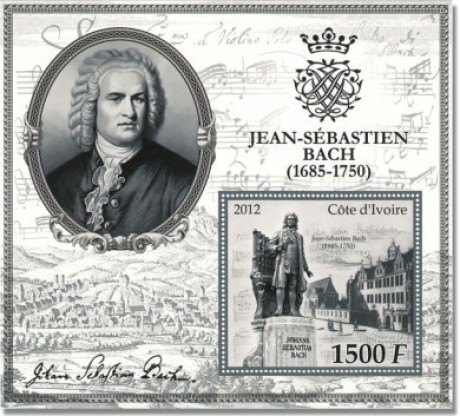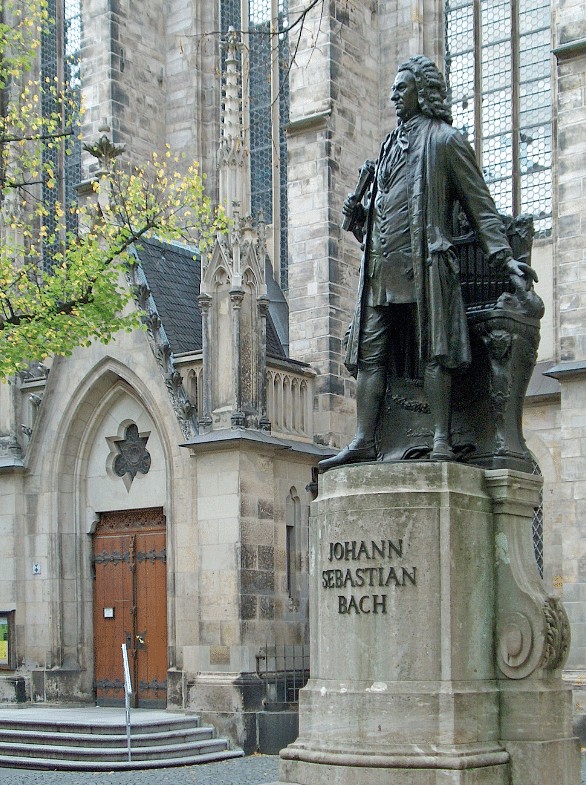Who’s the equivalent in the classical music world? Have you ever wondered who your favourite composer’s favourite composer was?
Sometimes it’s hard to tell from the historical record. Lots of great composers didn’t have a single favourite composer, or they never recorded their thoughts using those words exactly, so listeners are left to make educated guesses.
But even if we can’t always know their favourite, we can usually guess at their favourites. And a couple of names appear again and again… Read on to find out who!

© classicalregister.com
Johann Sebastian Bach (1685-1750)
When he was twenty years old, Johann Sebastian Bach set off on a 400-kilometre (250-mile) hike to the city of Lübeck.
His object was to hear the nearly 80-year-old organist Dieterich Buxtehude. Bach met him, heard his music performed, and even copied out some of his musical manuscripts.
Bach had originally intended to return home within a month, but he found Buxtehude’s work so fascinating that he stayed away for multiple months.
Understandably, relations with his employer were frayed upon returning home!
Bach also appreciated the work of Italian composer Antonio Vivaldi. He transcribed multiple Vivaldi violin concertos for organ. Read more about that: The “Harmonic Inspiration” of Antonio Vivaldi (1678-1741): “L’estro armonico”.
Bach’s personal thoughts and opinions are not well-documented, so we will never know for sure who Bach’s favourite composers were. But he was clearly impressed by these two.
Joseph Haydn (1732-1809)
Joseph Haydn met Wolfgang Amadeus Mozart sometime in the early 1780s.
In 1785, Wolfgang’s father, Leopold, recorded that Haydn told him:
Before God and as an honest man, I tell you that your son is the greatest composer known to me either in person or by name; he has taste, and, furthermore, the most profound knowledge of composition.
Wolfgang Amadeus Mozart (1756-1791)
In London in the mid-1760s, when Mozart was a boy, he studied with Johann Christian Bach, Johann Sebastian’s composer son.
In later years, Mozart remembered J.C. Bach’s instruction fondly, and he continued to seek out his new works in the following years.
Musicologist Alfred Einstein notes that, aside from Haydn, J.C. Bach was the only musician whom Mozart never criticised in his letters.
Mozart once told musical patron and diplomat Gottfried van Swieten, “Bach is the father. We are the children!”
Mozart also adored Haydn, writing six string quartets in his honour, known as the Haydn quartets.
Ludwig van Beethoven (1770-1827)
In 1817, English composer Cipriani Potter and Beethoven went on a walk in the woods together. Potter asked Beethoven, “Apart from yourself, who do you consider the greatest living composer?”
Beethoven’s answer was Italian composer Luigi Cherubini.
A few years later, Beethoven would write to Cherubini:
I am enraptured whenever I hear a new work of yours and feel as great an interest in it as in my own works – in brief, I honour and love you.
He also called him “Europe’s foremost dramatic composer.”
Learn more about Beethoven’s thoughts on Cherubini.
Beethoven also once said, “Handel was the greatest composer that ever lived. I would uncover my head and kneel before his tomb.”
Handel died a decade before Beethoven’s birth. Perhaps Handel was his favourite dead composer and Cherubini his favourite living one.
Richard Wagner (1813-1883)
Richard Wagner was just about to turn fourteen when Beethoven died. The loss shocked him to his core.
Richard would have dreams in which he spoke to Shakespeare and Beethoven, and wake up with his face wet with tears.
As a young composer, he was especially overwhelmed by the scale of Beethoven’s Ninth Symphony. He would later write:
Beethoven’s Ninth Symphony became the mystical goal of all my strange thoughts and desires about music… It was considered the ‘non plus ultra’ of all that was fantastic and incomprehensible, and this was quite enough to rouse in me a passionate desire to study this mysterious work.
He even made a piano transcription of it when still a student.
Frédéric Chopin (1810-1849)
In his biography of Frédéric Chopin, author Alan Walker writes:
The two composers Chopin admired above all others were Bach and Mozart – although we must question just how much Bach he knew…
The one work of Bach with which we know Chopin to have been intimately acquainted was the 48 Preludes and Fugues, many of which he mastered during his youth and could still play from memory in later life…
Mozart was a different matter. Chopin was familiar with the piano sonatas and some of the chamber music (especially the E major Piano Trio, K. 542, which he played in public), and his love of the operas was unconditional.
Perhaps his favourite Mozart opera was Don Giovanni, which he had known since his youth. But he adored as well the Requiem, which he is known to have heard twice in Paris, including the performance arranged for the reburial of Emperor Napoléon in 1840. It appears to have been this latter performance that generated a desire within him to have the work played at his own funeral, a wish that was carried out by his friends, though not without difficulty.
Learn more about Chopin’s funeral and the performance of Mozart’s Requiem that happened at it.
Here’s Chopin’s Op. 2, variations on a theme from Don Giovanni:
Felix Mendelssohn (1809-1847)
Felix Mendelssohn’s great-aunt Sarah Itzig Levy studied harpsichord with Johann Sebastian Bach’s eldest son, Wilhelm Friedemann Bach. She also commissioned work by another Bach son, Carl Philipp Emanuel Bach.
Sarah Itzig Levy helped keep the flame of appreciation for Johann Sebastian’s music burning even as his music fell out of fashion.
Felix’s father also bought a number of Johann Sebastian Bach’s manuscripts when Felix was a child.
In 1823 or 1824, when he was fifteen, his grandmother gifted Felix a score of the St. Matthew Passion.
Mendelssohn became obsessed. Just five years later, he mounted a performance of the Passion (albeit with a few cuts), helping to pave the path for a Johann Sebastian Bach renaissance in Germany.
Franz Liszt (1811-1886)
Toward the end of his long life, Franz Liszt claimed that in 1823, when he was still a boy, he performed for Ludwig van Beethoven. (At the time, Liszt was studying piano under Beethoven’s former student Carl Czerny.)
Liszt’s recounting of the details of the meeting was fuzzy, so his account has to be taken with a grain of salt. But supposedly he played a Bach fugue and the first movement of Beethoven’s C-major piano concerto.
When he finished, Beethoven kissed his forehead and declared:
Go! You are one of the fortunate ones! For you will give joy and happiness to many other people! There is nothing better or finer!
Decades later, Liszt would tell a student of the encounter, “This event in my life has remained my greatest pride—the palladium of my whole career as an artist.”
One thing we know for sure: Beethoven’s bravura style rubbed off on Liszt, and Liszt made landmark transcriptions of all nine Beethoven Symphonies for piano.
Liszt was also a major supporter of the music of his contemporary, Richard Wagner, who ended up marrying his daughter, Cosima. Liszt wrote transcriptions of Wagner’s works.
Liszt’s transcription of Wagner’s Liebestod from Tristan und Isolde
Johannes Brahms (1833-1897)
In the Cambridge Companion to Mozart, there’s a passage about Johannes Brahms’s relationship with Mozart’s music.
[Brahms’s] documented remarks on Mozart include stereotypical references to the perfection of Figaro and the beauty of the string quartets, but they also speak to a broader appreciation of Mozart’s stylistic range.
In conversation late in his life with the critic and composer Richard Heuberger, Brahms mentioned in passing that Mozart was more daring in his handling of form than Beethoven, and added: “It’s a good thing most people don’t know that.”
Pyotr Tchaikovsky (1840-1893)
Tchaikovsky and Brahms didn’t care for each other, but they both loved Mozart.
In his 1889 autobiography, Tchaikovsky wrote about hearing Don Giovanni as a teenager:
It was a pure revelation to me. It is impossible for me to describe the enthusiasm, the delight and intoxication which I was seized by.
During several weeks, I did nothing but play this opera through from the piano score; even as I fell asleep, I could not part with this divine music, which pursued me long into my happy dreams…
Amongst the great masters, Mozart is the one to whom I feel most attracted; it has been so ever since that day, and it will always be like that.
He wrote to his patroness Nadezhda von Meck in 1878:
I not only love Mozart – I worship him…
It is to Mozart that I am obliged for the fact that I have dedicated my life to music. He gave the first impulse to my musical powers and made me love music more than anything else in the world.
He later went on to write his fourth orchestral suite (nicknamed Mozartiana) to celebrate the centenary of Don Giovanni.
Gustav Mahler (1860-1911)
Gustav Mahler adored Beethoven so much that he took it upon himself to reorchestrate some of his symphonies.
Not surprisingly, the project was controversial!
But Mahler’s favourite composer may have been Richard Wagner. He spent much of his musical career as an opera conductor and spent years poring over and advocating for Wagner’s operas.
As a young composer, he famously said, “When Wagner has spoken, let others hold their tongues.”
Conclusion
It seems pretty clear that in the classical music world, Mozart and Beethoven would claim the crown of your favourite composers’ favourite composer! But the runners-up definitely include Wagner and members of the Bach family.
